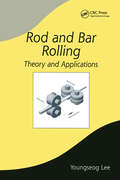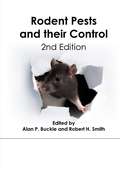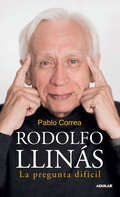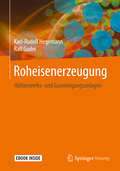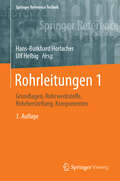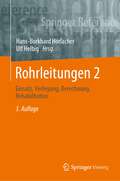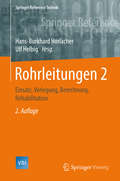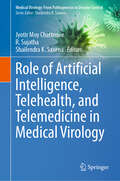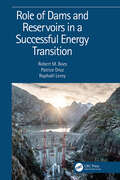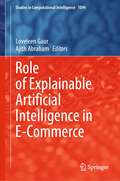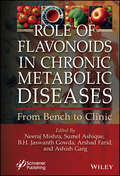- Table View
- List View
Rockets
by Joseph A. AngelSuitable for high school and general readers, this volume traces the evolution of the rocket from ancient Chinese fire arrows to ballistic missiles to the latest robotic spacecraft. It explains underlying scientific principles, provides capsule biographies of innovators in the field, and forecasts developments for the near and distant future. Features include b&w illustrations, a chronology, an extensive glossary, and a listing of cyberspace sites. Retired from the U.S. Air Force, Angelo teaches introductory astronomy (Rollins College, Florida) and is a technical writer/futurist. Annotation ©2007 Book News, Inc., Portland, OR (booknews.com)
Rockets and Ray Guns: The Sci-Fi Science of the Cold War (Science and Fiction)
by Andrew MayThe Cold War saw scientists in East and West racing to create amazing new technologies, the like of which the world had never seen. Yet not everyone was taken by surprise. From super-powerful atomic weapons to rockets and space travel, readers of science fiction (SF) had seen it all before. Sometimes reality lived up to the SF vision, at other times it didn’t. The hydrogen bomb was as terrifyingly destructive as anything in fiction, while real-world lasers didn't come close to the promise of the classic SF ray gun. Nevertheless, when the scientific Cold War culminated in the Strategic Defence Initiative of the 1980s, it was so science-fictional in its aspirations that the media dubbed it “Star Wars”. This entertaining account, offering a plethora of little known facts and insights from previously classified military projects, shows how the real-world science of the Cold War followed in the footsteps of SF – and how the two together changed our perception of both science and scientists, and paved the way to the world we live in today.
Rockets and Spaceships
by Karen WallaceThis Level 1 book is appropriate for children who are just beginning to read. Rockets do many jobs. They carry satellites and people into space and can be used as weapons. What else do you think they can do? For children who are just beginning to read and who have a limited vocabulary, these 32-page Level 1 books-about everything from tadpoles to puppies-use word repetition and simple sentences to convey meaning. Picture dictionary boxes with word labels "show" the meanings of words. These books contain between 400 and 450 words each, and they are 80 percent pictures and 20 percent text. The Dorling Kindersley Readers combine an enticing visual layout with high-interest, easy-to-read stories to captivate and delight young bookworms who are just getting started. Written by leading children's authors and compiled in consultation with literacy experts, these engaging books build reader confidence along with a lifelong appreciation for nonfiction, classic stories, and biographies. There is a DK Reader to interest every child at every level, from preschool to grade 4.
Rockets' Red Glare
by Greg DinalloCombining the narrative drive of the best of Clive Cussler with the knowledge of Tom Clancy, Rockets&’ Red Glare is the techno-thriller of the year about an ingenious coup that would change the balance in the world&’s arsenal foreverOn October 22, 1962, President Kennedy orders the US Navy to search all ships en route to Cuba. For six tense days, a frightened world watches as the two most powerful nations on Earth edge toward war. On October 28, under intense pressure, the Soviet Union agrees to dismantle its bases. The Cuban missile crisis is over.Or is it?Pensacola, Florida, 1987. Two naval officers of the Satellite Surveillance Group who have been tracking a Soviet Foxtrot class submarine suddenly come upon a mysterious VLCC supertanker—identity unknown. Hundreds of miles away in Houston, handsome millionaire industrialist Theodor Churcher takes off in his private helicopter for a clandestine rendezvous with the Soviet submarine in the Gulf of Mexico. Several days later, children playing on a beach in Louisiana find a severed arm floating in the surf—the fingerprints are those of Theodor Churcher. The final ominous moves in a brilliant Soviet strategy that began with the Cuban missile crisis are set in motion.Devastated by his father&’s death, young Andrew Churcher undertakes a dangerous mission to the Soviet Union to recover stolen blueprints that would not only avert the unfolding nightmare, but might cleanse his father&’s honor of the suspicion of treason. As he tracks a complex trail of move and countermove, Churcher is embroiled in a violent power struggle between two arms of Soviet intelligence. What Churcher doesn&’t know is that he is to be the bait in a deadly Soviet trap. From the cockpits of US fighters to the decks of Soviet navy vessels, from the back streets of Moscow to the oilrigs of Texas, Rockets&’ Red Glare is the ultimate techno-thriller.
Rockets: Two Classic Papers
by Robert GoddardRockets, in the primitive form of fireworks, have existed since the Chinese invented them around the thirteenth century. But it was the work of American Robert Hutchings Goddard (1882-1945) and his development of liquid-fueled rockets that first produced a controlled rocket flight. Fascinated by rocketry since boyhood, Goddard designed, built, and launched the world's first liquid-fueled rocket in 1926. Ridiculed by the press for suggesting that rockets could be flown to the moon, he continued his experiments, supported partly by the Smithsonian Institution and defended by Charles Lindbergh. This book is comprised of two papers he wrote for the Smithsonian. Among the most significant publications in the history of rockets and jet propulsion, these Smithsonian articles - the first published in 1919 and the second in 1936 - were issued at a time when little was known about these subjects. Goddard's first paper, "A Method of Reaching Extreme Altitudes," addressed the theoretical possibility of achieving great ranges by means of well-designed rockets. It also demonstrated that fairly high jet velocities were attainable and described advances in the construction of a solid cartridge magazine-type rocket. The second paper served as a progress report and indicated what had been accomplished through experimentation.Goddard went to to lay the foundations for the development of long-range rockets, missiles, satellites, and spaceflight. In fact, a liquid-fueled rocket constructed on principles he developed landed humans on the moon in 1969. Today, Goddard is widely recognized as the "Father of American Rocketry." According to The New York Times, "This . . . is certainly a book that the historian of rockets cannot ignore."
Rockfall Engineering
by Stéphane Lambert François NicotRockfall Engineering is an up-to-date, international picture of the state of the art in rockfall engineering. The three basic stages of rockfalls are considered: the triggering stage, the motion stage, and the interaction with a structure stage; along with contributions including structural characterization of cliffs, remote monitoring, stability analysis, boulder propagation, design of protection structures an risk assessment. Academic contributions are illustrated by practical examples, and completed by engineering contributions where practical purposes are thoroughly considered. This title is intended for engineers, students as well as researchers.
Rod and Bar Rolling: Theory and Applications (Manufacturing Engineering and Materials Processing)
by Youngseog LeeRod and Bar Rolling: Theory and Applications highlights the underlying relationship between solid mechanics and materials science. It provides a detailed overview of the deformation of material at high temperatures, an assessment of rod and bar rolling processes, and an in-depth review of the basics of hot rolling, elasticity, plasticity, and recry
Rodent Pests and Their Control
by David Cowan Adrian Meyer Roger Quy Alan P Buckle Hans-Joachim Pelz David W Macdonald Brian Wood Stephen Battersby Richard Shore Robert H Smith Michael Fall Colin Prescott Grant SingletonThe most numerous of the world's invasive species, rodent pests have a devastating impact on agriculture, food, health and the environment. In the last two decades, the science and practice of rodent control has faced new legislation on rodenticides, the pests' increasing resistance to chemical control and the impact on non-target species, bringing a new dimension to this updated 2nd edition and making essential reading for all those involved in rodent pest control, including researchers, conservationists, practitioners and public health specialists.
Rodent Pests and Their Control
by David Cowan Adrian Meyer Roger Quy Hans-Joachim Pelz David W Macdonald Brian Wood Stephen Battersby Richard Shore Michael Fall Colin Prescott Grant SingletonThe most numerous of the world's invasive species, rodent pests have a devastating impact on agriculture, food, health and the environment. In the last two decades, the science and practice of rodent control has faced new legislation on rodenticides, the pests' increasing resistance to chemical control and the impact on non-target species, bringing a new dimension to this updated 2nd edition and making essential reading for all those involved in rodent pest control, including researchers, conservationists, practitioners and public health specialists.
Rodent Quality Control: Monitoring Health and Genetics of Laboratory Animals (Laboratory Animal Science and Medicine #2)
by Fernando Benavides Axel Kornerup HansenThis book shows how and why quality assurance programmes should be implemented in laboratory rodent facilities to monitor animal health and genetic status. It covers common practice to assure the desired level of microbiological and genetic surveillance of both genetically standardized and genetically altered laboratory mice and rats. In particular, the book introduces readers to the standardized genetic nomenclature and provides step-by-step protocols for genetic monitoring of the animals. International standards of health monitoring programs are discussed and statistical aspects thereof are explored. Furthermore, the book reviews common infectious diseases in laboratory rodents and guides the reader in monitoring the animals’ health status through application of current diagnostic methods. This book adresses researchers, technicians and zookeepers working in laboratory rodent facilities.
Rodolfo Llinás
by Pablo Fabian Correa TorresLa única biografía sobre Rodolfo Llinás, el científico colombiano más importante en la actualidad. Los hallazgos científicos de Rodolfo Llinás son fascinantes y de una importancia capital para el estudio del cerebro a escala mundial. <P><P>Muchos de sus descubrimientos, como el de los canales de calcio P, las propiedades intrínsecas de las neuronas (o Ley de Llinás), ya hacen parte del canon de la ciencia. Después de cientos de horas de entrevistas con Llinás, con sus familiares, amigos y colegas, y de otras tantas en la búsqueda de archivos y álbumes familiares, Pablo Correa desmenuza para la buena comprensión de cualquier lector los hallazgos del neurocientífico colombiano más importante de todos los tiempos. <P>También lo embarca en aquel viaje por el río Magdalena que hizo a la edad de cuatro años, y lo lleva al instante en el que presenció un ataque de epilepsia en un paciente de su abuelo: momentos que quedaron para siempre en su mente y que serían fundamentales para decidir consagrar su vida al funcionamiento del cerebro y a encontrar la respuesta a la pregunta difícil.
Rogue Sequence: A Novel (Ander Rade #1)
by Zac ToppingIt's 2091 and independent contract companies around the world are producing genetically modified soldiers…to be sold to the highest bidders.Ander Rade is a super-soldier, a genetically engineered living weapon, and has been dutifully following orders since he gave himself to Scythe Industries’ Gene-Mod Program several years ago. But when a mission goes sideways, he’s captured, imprisoned, and forced into brutally violent fighting pits for the better part of the next decade…until agents from the Genetic Compliance Department of the United American Provinces appear in the visitors room.Things have changed since Rade was captured. Shortly after his incarceration, the World Unity Council banned human genetic engineering and deemed all modified individuals a threat to society. Overnight, an entire subculture of people became outlaws simply for existing. But instead of leaving Rade locked behind bars, the GCD agents have come with an offer: Freedom in exchange for his help tracking down one of his former teammates from that ill-fated mission all those years ago.It's an offer Rade can't refuse, but he soon realizes the situation is far more volatile than anyone had anticipated, and must take matters into his own hands as he tries to figure out whose side he’s really on, and why?At the Publisher's request, this title is being sold without Digital Rights Management Software (DRM) applied.
Rogue Waves in Integrable Systems
by Bo Yang Jianke YangThis book offers a holistic picture of rogue waves in integrable systems. Rogue waves are a rare but extreme phenomenon that occur most famously in water, but also in other diverse contexts such as plasmas, optical fibers and Bose-Einstein condensates where, despite the seemingly disparate settings, a common theoretical basis exists. This book presents the physical derivations of the underlying integrable nonlinear partial differential equations, derives the explicit and compact rogue wave solutions in these integrable systems, and analyzes rogue wave patterns that arise in these solutions, for many integrable systems and in multiple physical contexts. Striking a balance between theory and experiment, the book also surveys recent experimental insights into rogue waves in water, optical fibers, plasma, and Bose-Einstein condensates. In taking integrable nonlinear wave systems as a starting point, this book will be of interest to a broad cross section of researchers and graduate students in physics and applied mathematics who encounter nonlinear waves.
Rogue: An Ike Schwartz Mystery (Ike Schwartz Series #7)
by Frederick Ramsay"Ike Schwartz outing combines high-tech detection with routine sleuthing" —BooklistRuth Harris, Sherriff Ike Schwartz's fiancée, is involved in a near fatal automobile accident. But Ike is convinced the crash was rigged. Even though he is embroiled in a close election, has no jurisdiction over the investigation, and can find no support in the usual law enforcement community, he places himself on leave and goes rogue to investigate and seek the person or persons responsible for putting Ruth in a coma.Help arrives from unexpected and irregular sources. Old friends in the covert community step up and his loyal staff in Picketsville provide undercover assistance. The journey leads Ike to state's rights organizations, then to several zealots and dissident academics before it finally ends at home in Picketsville.
Roheisenerzeugung: Hüttenwerks- und Gasreinigungsanlagen
by Karl-Rudolf Hegemann Ralf GuderDieses Buch beschreibt die metallurgischen Vorgänge, Thermodynamik, Strömungsmechanik und Verfahrenstechnik der Roheisenerzeugung im Hinblick auf die Hüttenwerks- und Gasreinigungsanlagen. Zahlreiche Abbildungen veranschaulichen den die Beschreibungen.
Rohrleitungen 1: Grundlagen, Rohrwerkstoffe, Rohrherstellung, Komponenten
by Hans-Burkhard Horlacher Ulf HelbigAls Springer Reference bietet die nunmehr 3. Auflage des Fachbuchs Rohrleitungen 1 und 2 eine anspruchsvolle, wissenschaftlich fundierte Fakten- und Wissenssammlung, die sich auf den kompletten Bereich der Rohrleitungstechnologie erstreckt. Das Buch stellt eine unentbehrliche Hilfe zum konstruktiven Verständnis, zur Funktionsweise und zum Betrieb von Rohrleitungen aller Art dar. Band 1 versteht sich als Basis zum Band Rohrleitung 2 und dessen Schwerpunkten zu Einsatzfeldern von Rohrleitungen, deren Bemessung und Berechnung, zu Verlegung und Einbau sowie zur Rehabilitation oder Sanierung von Altleitungen. Der Teil Rohrleitung 1 richtet den Fokus auf die Grundlagen, Rohrwerkstoffe, Rohrherstellung und auf wichtige Rohrleitungskomponenten wie Armaturen, Messeinrichtungen oder Kompensatoren. Zahlreiche Abbildungen und Diagramme, Tabellen sowie Beispiele runden die Ausführungen ab.
Rohrleitungen 2: Einsatz, Verlegung, Berechnung, Rehabilitation
by Hans-Burkhard Horlacher Ulf HelbigAls Springer Reference bietet die nunmehr 3. Auflage des Fachbuchs Rohrleitungen 1 und 2 eine anspruchsvolle, wissenschaftlich fundierte Fakten- und Wissenssammlung, die sich auf den kompletten Bereich der Rohrleitungstechnologie erstreckt. Das Buch stellt eine unentbehrliche Hilfe zum konstruktiven Verständnis, zur Funktionsweise und zum Betrieb von Rohrleitungen aller Art dar. Band 2 versteht sich als Erweiterung zum Band Rohrleitung 1 und dessen Schwerpunkten zu den unterschiedlichen Rohrwerkstoffen, der Rohrherstellung oder den betriebswichtigen Rohrleitungskomponenten. Der Teil Rohrleitung 2 richtet den Fokus auf die verschiedenen praktischen Einsatzfelder von Rohrleitungen, deren Bemessung und Berechnung, die Verlegung und den Einbau sowie die Rehabilitation bzw. Sanierung von Altleitungen. Zahlreiche Abbildungen und Diagramme, Tabellen sowie Beispiele runden die Ausführungen ab.
Rohrleitungen 2: Einsatz, Verlegung, Berechnung, Rehabilitation (Springer Reference Technik)
by Hans-Burkhard Horlacher Ulf HelbigAls Springer Reference bietet die Neuauflage des Fachbuchs eine anspruchsvolle, wissenschaftlich fundierte Fakten- und Wissenssammlung, die sich auf den kompletten Bereich der Rohrleitungstechnologie erstreckt. Im zweiten Band werden die anwendungsorientierten Themen vertieft. Der praktische Nutzen berücksichtigt sowohl planerische Erfahrungen als auch Erfahrungenmit Betriebsszenarien, die zur Instandhaltung und Erneuerung bestehender Systeme herangezogen werden können. Das Buch stellt eine unentbehrliche Hilfe zum konstruktiven Verständnis, zur Funktionsweise und zum Betrieb von Rohrleitungen aller Art dar. Als Erweiterung zu Band 1 und dessen Ausführungen zu verschiedenen Werkstoffen, Rohrkonstruktionen, Rohrleitungskomponenten und Zubehör erläutert der Band 2 schwerpunktmäßig neben den Einsatzfeldern und dem Einbau von Rohrleitungen auch deren Berechnung und Auslegung sowie die Instandhaltung und Rehabilitation. Zahlreiche Abbildungen und Diagramme, Tabellen sowie Beispiele runden die theoretischen Ausführungen ab.
Rohrleitungs- und Apparatebau
by Günter ScholzVon einem erfahrenen Praktiker geschrieben, liefert der Band sowohl das theoretische als auch das praktische Wissen für die Planung und Ausführung von Rohrleitungen und Versorgungsrohrnetzen für Hochdruckdampf, Heißwasser, Druckluft und Kühlwasser. Der Autor leitet die strömungstechnischen und konstruktiven Grundlagen sowie alle für den Rohrleitungs- und den Apparatebau erforderlichen Berechnungsverfahren her und demonstriert ihre Anwendung in vollständig durchgerechneten Beispielen. Das Buch enthält Tabellen mit Stoffwerten sowie Arbeitsdiagramme.
Role of Artificial Intelligence, Telehealth, and Telemedicine in Medical Virology (Medical Virology: From Pathogenesis to Disease Control)
by R. Sujatha Jyotir Moy Chatterjee Shailendra K. SaxenaThe book explores the intersection of AI, telehealth, and viral infections, discussing the role of AI in pandemics, telehealth services, viral diagnosis, and antiviral drug development. It explores the integration of AI into telehealth, predicting outbreaks and monitoring mutations. The book emphasizes patient-centric healthcare, highlighting AI's transformative potential in infectious diseases. It covers medical virology, bioinformatics, machine learning, and neural networks. AI enables streamlined workflows, improved patient care, and new research methodologies. It addresses challenges and tailored solutions for AI integration in telehealth. It serves as a valuable resource for clinicians, physicians, virologists, researchers, and healthcare professionals seeking to navigate the evolving landscape of telehealth and harness the full potential of AI in transforming healthcare delivery.
Role of Circular Economy in Resource Sustainability (Sustainable Production, Life Cycle Engineering and Management)
by Ming Xu Pezhman Ghadimi Michael D. GilchristThis book aims to provide academic and industrial applications advancing the critical role of circular economy principles in the sustainability of various resources. The latest research and practice in resource sustainability are shared, discussed, and promoted. The core competency of this book revolves around providing recent advances in sustainable consumption and production implementations, developed tools for environmental and sustainability assessment, technological advancements in resource and waste management/treatment, and advances in waste reduction, reuse, recycling, and recovery. Resources are defined broadly to include (1) physical resources: metals, non-metallic minerals, energy, and water (2) biological resources: food, forestry, land, ecological systems, etc., and (3) “misplaced” resources: air emissions, water pollutants, and solid waste. Finally, legislation, and policy implications and recommendations for resources sustainability are concluded.
Role of Dams and Reservoirs in a Successful Energy Transition: Proceedings of the 12th ICOLD European Club Symposium 2023 (ECS 2023, Interlaken, Switzerland, 5-8 September 2023)
by R. BoesToday, new and unexpected challenges arise for Europe’s large array of existing dams, and fresh perspectives on the development of new projects for supporting Europe’s energy transition have emerged. In this context, the 12th ICOLD European Club Symposium has been held in September 2023, in Interlaken, Switzerland. The overarching Symposium theme was on the "Role of dams and reservoirs in a successful energy transition". The articles gathered in the present book of proceedings cover the various themes developed during the Symposium: - Dams and reservoirs for hydropower - Dams and reservoirs for climate change adaptation - Impact mitigation of dams and reservoirs - How to deal with ageing dams In conjunction with the Symposium, the 75th anniversary of the Swiss Committee on Dams offered an excellent opportunity to not only draw from the retrospective of Switzerland’s extensive history of dam development, but to also reveal perspectives on the new role of dams for a reliable and affordable energy transition. These aspects are illustrated by several articles covering the various activities, challenges, and concerns of the dam community.
Role of Data-Intensive Distributed Computing Systems in Designing Data Solutions (EAI/Springer Innovations in Communication and Computing)
by Vijayalakshmi Saravanan Sarvesh Pandey Udai Shanker Rajinikumar RamalingamThis book discusses the application of data systems and data-driven infrastructure in existing industrial systems in order to optimize workflow, utilize hidden potential, and make existing systems free from vulnerabilities. The book discusses application of data in the health sector, public transportation, the financial institutions, and in battling natural disasters, among others. Topics include real-time applications in the current big data perspective; improving security in IoT devices; data backup techniques for systems; artificial intelligence-based outlier prediction; machine learning in OpenFlow Network; and application of deep learning in blockchain enabled applications. This book is intended for a variety of readers from professional industries, organizations, and students.
Role of Explainable Artificial Intelligence in E-Commerce (Studies in Computational Intelligence #1094)
by Ajith Abraham Loveleen GaurThe technological boom has provided consumers with endless choices, removing the hindrance of time and place. Understanding the dynamic and competitive business environment, marketers know they need to reinforce indestructible customer experience with the support of algorithmic configurations to minimize human intrusion. World Wide Web (WWW) and online marketing have changed the way of conducting business; with artificial intelligence (AI), business houses can furnish a customized experience to fulfil the perceived expectation of the customer.Artificial intelligence bridges the gap between business and prospective clients, provides enormous amounts of information, prompts grievance redressal system, and further complements the client’s preference. The opportunities online marketing offers with the blend of artificial intelligence tools like chatbots, recommenders, virtual assistance, and interactive voice recognition create improved brand awareness, better customer relationshipmarketing, and personalized product modification.Explainable AI provides the subsequent arena of human–machine collaboration, which will complement and support marketers and people so that they can make better, faster, and more accurate decisions. According to PwC’s report on Explainable AI(XAI), AI will have $15.7 trillion of opportunity by 2030. However, as AI tools become more advanced, more computations are done in a “black box” that humans can hardly comprehend. But the rise of AI in business for actionable insights also poses the following questions: How can marketers know and trust the reasoning behind why an AI system is making recommendations for action? What are the root causes and steering factors? Thus, transparency, trust, and a good understanding of expected business outcomes are increasingly demanded.
Role of Flavonoids in Chronic Metabolic Diseases: From Bench to Clinic
by Neeraj Mishra Sumel Ashique Ashish Garg Arshad Farid B.H. Jaswanth GowdaThis comprehensive volume covers the entire field of flavonoids by explaining their complex functions in reducing chronic metabolic illnesses, from the early stages of laboratory research to the development of therapeutic uses. Flavonoids are plant-based substances proven to have potential medical benefits in managing chronic metabolic disorders. This book explores concepts in laboratory research and therapeutic capabilities to enhance awareness of flavonoids in a medical context. The book begins with a thorough examination of the basic biochemical and molecular processes that underlie long-term metabolic disorders. It looks into these bioactive substances, from their natural origins to the synthesis of innovative derivatives. Analyzing both lab research and preclinical trials critically, it provides a solid basis for understanding the exciting opportunities flavonoids bring in treating metabolic diseases. The scope of this work extends beyond theoretical domains into clinical environments. It closes the gap between bench-side findings and bedside applications by revealing the translational potential of flavonoids. It is possible to understand the practical implications and future directions of flavonoid-based therapeutics through the synthesis of evidence-based clinical studies, therapeutic approaches, and possible healthcare issues. Readers will find the book: contains cutting-edge insights into metabolic disease research and delves into recent discoveries on the molecular mechanisms of flavonoids; facilitates a viewpoint into the findings of practical clinical implementations and the progression of flavonoid investigations from controlled experimental environments to prospective therapeutic interventions; explores the scientific effects of flavonoids on chronic metabolic disorders; presents evidence from human trials and epidemiological research on flavonoid clinical processes; encompasses various aspects of preventive measures for managing widespread metabolic diseases, containing dietary recommendations, lifestyle interventions, and the potential involvement of flavonoids; offers a comprehensive guide on how to effectively utilize flavonoids for therapeutic purposes. Audience This book is intended for researchers, scientists, clinicians/physicians, and public health professionals who work in pharmacology settings. The book is a vital tool for clinicians, nutritionists, and other healthcare professionals who are concerned about cutting-edge methods for dietary guidelines to gain an understanding of flavonoids and long-term metabolic disorders.






